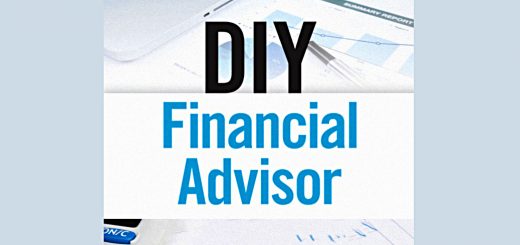The DIY Financial Advisor 2 – Experts Again

Today’s post is our second visit to a new book – The DIY Financial Advisor from the team at Alpha Architect.
Contents
DIY Financial Advisor
DIY Financial Advisor is a book from the team at Alpha Architect, an asset manager and a consultancy to family offices.
The thesis of the book is that the DIY Investor can make long-term decisions designed to maximise risk-adjusted-performance after fees and taxes.
- In contrast, the fund manager has short-term incentives which conflict with this goal.
The themes of the book are that you can do better than the “experts”, but that you need to avoid psychological traps and stick to an investing framework.
In our first visit, AA made a convincing case that a systematic DIY investor – armed with a model – can beat the experts:
- Experts are self-interested, susceptible to the same behavioural biases as the rest of us, and rely on stories rather than facts.
Humans are prone to poor decision-making across a broad range of situations.
Or as Dan Ariely puts it:
The human mind is predictably irrational.
Systematic decision-making (which uses models) outperforms discretionary decision making (using experts).
The (erroneous) idea that experts can outperform relies on three incorrect assumptions:
- That qualitative information increases forecast accuracy.
- That more information increases forecast accuracy.
- That experience and intuition increase forecast accuracy.
Humans have three key problems:
- Inconsistency
- Overconfidence
- Reliance on stories
Bias and confidence
In Chapter 3, AA provides a bit more detail on why experts underperform.
They focus on five issues:
- Anchoring
- Framing
- Availability
- Physical state, and
- Overconfidence
We’ve covered anchoring several times before.
- Even completely unrelated numbers (such as national insurance numbers, or arbitrary dates) affect our estimates of the price/value of an object.
- This principle underlies the use of “sales” in retail stores.
Framing exploits our natural tendency to compare things to other things close to them and attach meaning from adjacent words.
- So in AA’s example, a circle surrounded by larger circles appears smaller than a circle of the same size which is surrounded by even smaller circles.
- For the same reason, 75% lean sounds better than 25% fat and a 90% chance of living sounds better than a 10% chance of dying.
In investment, this means that salesmen will use nominal fund value s rather than real geometric growth rates since the former make the growth seem more impressive.
Availability makes us overweight information that is readily visible or easily recalled.
- Most people say that more words start with k than have k in the third position.
- That’s because we aren’t trained to recall words by their third letter.
Availability is the reason that newspaper headlines can temporarily change people’s opinions about the likelihood of future events.
Physical state is not studied as much as other behavioural traits, but Bodenhausen found that morning types were more likely to find a defendant guilty in the evening, whilst evening types were more likely to convict in the afternoon.
To illustrate overconfidence, AA uses the estimation game, where you need to supply high and low values that correspond to your 90% confidence interval for the question.
- On average people’s answers span only 30% of the correct values, rather than the 90% that they believe.
It seems that people seek out irrelevant information, and then overweight it in their decision-making process.
- They are overconfident that the extra information has significance.
Stories
Chapter 4 is about the stories that experts tell us.
It begins with the story of the cargo cults in the Melanesian islands.
- Used as airbases during the war, the flow of western goods dried up when the war ended and the planes stopped landing.
To entice the planes back, the islanders created elaborate facsimiles of the airstrips, control towers and marching drills that had previously accompanied the cargo.
- They needed a story to explain what had happened, and they mistook correlation for causation.
They also report how pigeons develop superstitions about the movement patterns which they believe cause food pellets to appear in their cages.
- And that children believe in Santa, though adults don’t.
They compare these with the many superstitions about the stock market, a lot of which are seasonal.
- The point is not that all are true or false, but that you shouldn’t accept any without seeing some evidence.
Buffet vs Graham
AA offers a comparison of Buffett’s performance to that of his mentor Ben Graham.
- Graham had a strict value focus, whereas Buffett is well-known for preferring a wonderful stock at a fair price to a fair stock at a wonderful price.
Here are the three rules that summarise the Graham approach:
It’s a little more complicated to choose the Buffett stocks:
- Rank stocks on EBIT / TEV (total enterprise value) – the cheapness measure
- Rank then again on EBIT / capital employed – the quality measure
Average the two ranks and choose the stocks with the lowest averages.
The Buffett portfolio easily beats the market, but It turns out that the Graham portfolio does best (in the US, from 1974 to 2011).
- It returns 16.0% pa compared to 14% pa for Buffett and 10.5% pa for the S&P 500.
- It has the best Sharpe ratio and the best Sortino ratio.
- Both the Graham and Buffett portfolios have better max drawdowns than the S&P 500.
The reason is that the Buffett strategy overpays for Quality.
- AA shows that over the period in question, Quality underperforms the S&P 500.
AA have done a lot of work on this, and have a book called Quantitative Value, which I might review at some point in the future.
- It seems that the quality attributes in question are not useful if the stock isn’t already cheap.
In other words, GARP doesn’t work as well as people think, or as well as a plain value strategy.
Other myths
AA looks at two other stock market myths.
The first is the idea that economic growth drives stock returns.
- In fact, there is almost no correlation (based on work by Jay Ritter looking at 16 countries from 1900 to 2002).
Buffett is famous for pointing out how high-growth industries often turn out to be terrible investments (airlines, cars, radio and TV).
- You need instead to focus on dominance by a particular company, and on the durability of that company.
- This is “moat” investing.
AA offers a theory that if the price you pay is the key driver of returns, it may be better to invest during times of low economic growth when you are less likely to pay over the odds.
The second myth is that high payout ratios (ie. paying a lot of profits out as dividends) will dampen future growth.
- The idea is that cash is needed for reinvestment in future projects, to make the firm grow.
But in fact, it works the other way around – higher dividend payout ratios predict higher future growth.
AA offer three explanations (from Rob Arnott):
- Since dividend cuts are unpopular, managers making high payments must be confident they can be maintained (ie. they think the firm has good future prospects)
- Earnings not paid out are invested in poor projects
- Retaining cash is an indicator of empire building and an acquisitive strategy.
Against models
People identify with people, not with models.
- And they think that their experience of the world must count for something.
They want self-actualisation.
So they cling to the idea that on-the-fly modifications can add value to a model.
- This idea – known as the “broken leg theory” is half right.
It is possible for a human modification to add value.
- But humans don’t stop at a single modification to deal with an obvious error.
They make many modifications until the net effect is to subtract value from the model.
Conclusions
That’s it for today.
- We’re around forty per cent of the way through the book, with another three articles to come (plus a summary).
I’ve enjoyed today’s read, though much of it was familiar.
- I’m looking forward to part two of the book which explains how to beat the experts.
Until next time.














